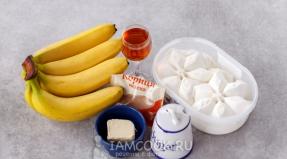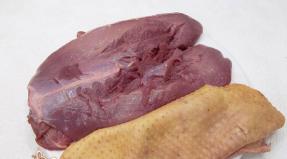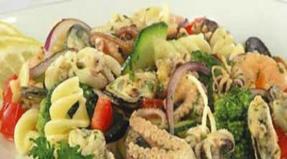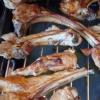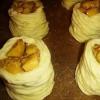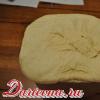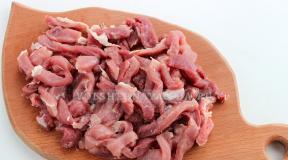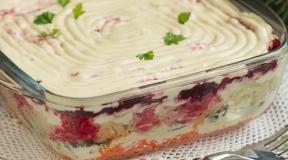Make your own bread. A simple recipe in a slow cooker
How many proverbs and sayings about bread were invented by the people, not to count. Since ancient times, bread has been revered and treated with great respect. Bread is the head of everything! To this day, it is a staple food. You won't be full without bread.
Baking is a labor-intensive and time-consuming activity, but this is all offset by the pleasure that you get from a delicious, fragrant loaf baked with your own hands.
Bread can be baked in the oven, in the oven, in a bread machine, from yeast dough and dough without yeast.
We will present you several recipes for bread, appetizing, unique in taste.
Let me start by reminding you.
- In the old days they said that the taste of bread depends on good hands and a good heart.
- Important, for tasty, high-quality bread, is flour and pure water, their correct ratio in the dough
- I would especially like to note that when kneading the dough, the room should be warm, and the flour should not be cold.
- When preparing yeast, they must be thoroughly mixed with water, adding a small amount of flour
- The kneaded dough needs to be put in a warm place for fermentation for 4-6 hours.
- Well-fermenting dough is porous, smells of alcohol and has a convex shape on top
- At the time of fermentation, the dough must be covered with a towel
How to make sourdough for yeast-free dough, you can read more
Recipes for delicious bread from yeast dough in the oven
Bread at home from A to Z
How to bake white wheat bread at home
To make this bread, for 1 kg of wheat flour you will need to cook
- 2 glasses of water
- 30 - 40 g of yeast,
- 1 st. spoon of salt
- 2 tbsp. l. Sahara,
- 1 - 2 tbsp. l. vegetable oil
- 1 st. l. butter

Let's start kneading the test. Take half the flour, mix it with 1.5 cups of water and yeast. Mix it all very well. It is better to dilute the yeast first and add it to the flour. It is best to knead the dough with your hands, if necessary, slightly adding flour, until it stops sticking to the walls of the pan.
Keep in mind that the pan should be large enough so that the dough can freely increase in size by 3 times.
Cover with a towel, put the pan in a warm place for 3 - 4 hours, periodically kneading it (about every hour).
After the dough has increased by 1.5 - 2 times, knead the dough again, adding the rest of the flour, water, salt, sugar and vegetable oil to it. If you want the dough to be more rich, add one egg to it. Knead everything well, and cover the pan, put again in a warm place for 1.5 hours.
 Prepare the forms, it can be a deep baking sheet, a saucepan, special baking dishes, grease them with oil and spread the dough in them, keep in mind that you should not fill the forms completely, as the dough will increase in size during baking.
Prepare the forms, it can be a deep baking sheet, a saucepan, special baking dishes, grease them with oil and spread the dough in them, keep in mind that you should not fill the forms completely, as the dough will increase in size during baking.
Put the forms for 20-40 minutes in a warm place, preferably to a warm battery. The dough will rise a little more.
Now the most crucial moment - we bake bread. If there is an elevated temperature and low humidity in the oven, we can get low, unbaked, hard bread, so the temperature and humidity must be created.
First, heat the oven to 160 - 180 degrees and put a bowl of water on the bottom of the oven. Place the molds on the middle shelf and hold for 6 - 10 minutes, then raise the temperature to 220 - 280 degrees, bake until cooked, at the end of baking, reduce the temperature again to 180 degrees. Baking time depends on the weight of the loaf, with 1.5 kg - about 1.5 hours.
After taking the bread out of the oven, brush it with a 1:1 diluted egg with water or butter. Cover with a towel and leave to cool. After it cools down, you can take it out of the mold.
Start baking - we are sure you will succeed.
An old recipe for homemade yeast bread
 To bake this bread you will need:
To bake this bread you will need:
- 10 g yeast
- 0.5 cup warm water
- 1 glass of warm milk
- 4 tbsp. l. vegetable oil
- 1 tsp salt
- wheat flour as needed
It is necessary to pour the yeast into warm water with the addition of 1 tablespoon of flour, mix everything thoroughly. Add salt, milk and butter.
While stirring, add a little flour until the dough becomes cool, while soft, tender and does not stick to your hands.
Divide the whole dough into several small balls. Flatten slightly and place on a baking sheet. Load into hot oven and bake for approximately 10 minutes.
Readiness check with a match, piercing the bread, if the dough does not stick to the match, the bread is ready. Take it out and put it on a wooden board, covering it with a towel for 20 minutes.
In old Russian recipes, it was advised to grease the form with hemp oil, and before baking bread, keep the flour in a warm place for two days.
How to bake homemade rye bread in the oven
According to professional bakers, real rye bread can only be baked in a Russian oven. Only in it you can get the aroma of real rye bread, while the loaves should be large - five kilograms.

Well, there are few housewives who have the opportunity to use the Russian oven, and yet we dare to use this recipe for baking it at home in our modern apartments.
To complete our recipe, you will need 2 cups of sifted rye flour, 1 cup of water, 25 g of yeast, salt at the tip of a teaspoon.
Take a bowl, put flour in it. Dilute the yeast with water, pour it into a bowl, salt and knead the dough so that it is soft, smooth, uniform.
Make a bun out of it, leave it in a warm place for 1.5 hours. The dough will ferment and rise, and the aroma of fermented rye dough will come from it.
After that, knead it well again, place it on a prepared baking sheet, pre-oiled, shape it.
Wait about an hour for the dough to rise, send it to the oven, heated to 230 degrees for 30 minutes, after sprinkling it with water.
Ready bread, remove from the mold and lightly moisten with water on top, cover with a towel to cool.
Break off a piece of fragrant tasty bread and try it with cold milk. The taste is unforgettable.
A simple recipe for baking milky white bread
For this recipe, prepare based on 850 g of wheat flour -
- 1 glass of milk
- 100 g sugar
- 150 g butter
- 20 g yeast
- 3 eggs and salt on the tip of a knife
First, dilute the yeast with warm milk, add half the sugar and 100 grams of flour, make a batter, leave it in a warm place for 1 hour.
At this time, we will make the filling, for this, rub the butter so that it becomes white, combine with egg yolks, salt and sugar. Pound all this very well until a liquid homogeneous mass is obtained.
Whisk the remaining whites.
Put the dough in a large saucepan, add flour, filling, proteins. Knead the dough well, divide into 2 equal parts, shape the loaves and place them in pre-oiled molds.
The top of the roll can, if desired, sprinkle with crushed nuts, grease with an egg. Bake at a temperature of approximately 180 degrees for 45 minutes.
Recipes for homemade bread dough without yeast
We bake a bun according to the recipe with cinnamon and raisins

Take the yolks from 5 eggs and mix with 100 g of powdered sugar until smooth.
0.5 tsp ground cinnamon, 3 grains of cloves, half a glass of pitted raisins, grated peel of one lemon, add to the resulting mass and mix it all.
Beat the whites, add to the mass and adding 50 g of wheat flour, knead the dough well.
Bake in a greased form, over low heat for 30 minutes.
vanilla potato bread recipe
Pound the yolks with powdered sugar until white, add whipped cream, potato flour, vanillin and knead everything well.
Take a form, preferably round, grease with oil and sprinkle with flour on top, place the dough in it.
Bake in the oven until done.
The composition of this bread –
- 120 g potato flour
- 10 egg yolks
- 5 proteins
- 150 g powdered sugar
- 0.5 teaspoon vanillin
Corn flour bread in the oven without yeast
Make a homogeneous mass consisting of 3 egg yolks, 150 g of powdered sugar, add 1 cup of sifted corn flour, grated zest, juice from one lemon to it. Mix it all well.
Beat whites from 12 eggs and pour into the dough, mix lightly.
Bake over low heat in a greased and floured form.
Bread recipes from yeast dough in a bread machine
We bake in a bread machine Tex-Mex bread with sweet pepper

Since many, today, have electric bread machines in their household kitchens, we decided to give two, in our opinion, original recipes for delicious bread. There are many varieties of bread machines, and we will do this in a fairly common, Tefal model, the easiest to use.
- 225 ml water
- 30 g tomato paste
- 6 g salt (1 tsp)
- 290 g sifted wheat flour
Place the container in the bread maker, select mode 5 (baking French bread), product weight 750 g, crust color and start. After the signal, add 100 g of red, yellow and green sweet peppers, cut into small cubes.
How to bake Hawaiian bread in a bread machine

On a 750 g roll, place the products in the container in the following sequence:
- 135 ml milk
- 1 egg
- 7 g salt (1 tsp)
- 75 g sugar
- 375 g sifted wheat flour
- 5 g dry yeast (in 1 tsp - 3 g dry yeast)
Place the container in the bread maker, select mode 6 (highest baking bread), product weight 750 g, crust color and start. After 5 minutes, after the start of kneading, open the lid and add 70 g of soft butter.
After the signal, add 30 g of cocoa powder and 80 g of pineapples, cut into cubes. At the beginning of the baking process, brush the crust with a beaten egg, sprinkle with 10 g of cocoa powder and decorate with 30 g of pineapple rings.
Watch the video how to bake in a bread machine and the recipe
Video recipe from the chef Homemade rustic bread
10 recipes for making bread at home
The most delicious bread is, of course, the one you baked with your own hands.
Bread on the table is a constant symbol of well-being and prosperity. Bread is a symbol of labor, home, family happiness. No one will doubt that one of the most amazing smells on earth is the smell of freshly baked bread. How tasty it is to eat a crispy crust!Bread has always been valued and considered holy. People were anxious about grain, the harvest of a rich harvest was a holiday. Since ancient times in Russia they have been baking bread, monasteries have always been especially famous for this.
Recently, the tradition of home baking has returned. And even if it takes a lot of patience, attention, reverent attitude to the product, it's worth it. Homemade bread is the best!
1. Homemade Russian bread
Compound:
. water - 350 ml
. dry yeast - 1 teaspoon, or fresh yeast - 25 g
. sugar - 1 teaspoon
. flour - about 0.5 kg
. salt - 1 teaspoon
. cumin - to taste
. vegetable oil - 2-3 tablespoons
Cooking method:
1.
Pour yeast, sugar and a teaspoon of flour into a half-liter mug, mix everything dry, and then mix by adding a little water. Then pour out the rest of the water and mix again. Water should be very warm, boiled. Place the mug in a warm place. The resulting yeast wiring is ready when a head of foam appears on it. This takes about half an hour.
2.
Pour the yeast wiring into a two-liter bowl, add 1 cup of flour there and mix thoroughly. Place the resulting mixture in a warm place for about 1 hour, until the mixture rises, turning into foam. This is how steam is made.
3.
Add vegetable oil, salt, cumin to the dough, mix everything thoroughly and knead the dough, gradually adding flour (first a glass, at the end half a glass or less). While the mixture is liquid, knead with a spoon, when it thickens, knead with your hands right in the bowl. When the dough stops sticking to your hands and dishes, it means that you do not need to add more flour. It is important to catch this moment and not shift the flour. Form the finished dough into a bun, transfer to another larger bowl (with a capacity of 4 liters). Sprinkle the bowl with flour first to make the dough less sticky, and put in a warm place.
4.
When the dough has risen after an hour or two, filling almost the entire bowl, knead it and let it rise again. At the same time, you can add a little flour if the dough began to stick to your hands. After the second rise, it must be kneaded again, and the bun of dough should be placed on a baking sheet.
5.
Lubricate the baking sheet with vegetable oil, then the baking dough and place in a warm place for about an hour or less. Here it is no longer necessary to wait for a very large rise in the dough, so that large gas bubbles do not form in the bread. For the same purpose, before planting the dough in the oven, pierce the dough with a large needle from above and almost to the bottom, making at least 20 punctures.
6.
Put the baking sheet with the dough in the oven preheated to 200 degrees Celsius. At the same temperature, bake bread for about 40 minutes, you can take longer, but no more than 1 hour. The readiness of bread is judged by the color of the top crust. It should be uniform brown.
7.
After the bread is ready, take it out, wrap it in a towel, cover with plastic wrap and soak for 30 minutes. As a result of this, the bread crust will soften and will not be tough.
2. Rye bread
Compound:
. salt - 1 tablespoon
. vegetable oil - 1 tablespoon
. cumin seeds - 3 tablespoons
. wheat flour - 3 cups
. rye flour - 3 cups
. sugar - 1 tablespoon
. yeast - 2 tablespoons
. water - 3 glasses
Cooking method:
1.
For the dough, mix warm water, yeast, sugar and leave until frothy. Mix rye flour, wheat flour, cumin seeds and salt. Pour the dough into the flour and knead until a soft dough forms. Cover with a towel and set aside for about 1 hour in a warm place. After the dough has risen, divide it in half, place on a greased baking sheet and leave for 2 hours.
2.
Preheat the oven to high temperature and place a baking sheet in it. Bake for about 1 hour until browned. Lubricate the surface with a brush with milk or butter. Refrigerate 15 minutes before removing from bread pans. Add beauty and flavor to bread with a sprinkle. It can be added at different stages of bread baking: at the beginning of baking, 10 minutes after the start of baking, or immediately after the end of baking, while the bread is still hot. If you want to sprinkle bread at the start of baking, simply open the lid quickly to lose as little heat as possible. Before adding the topping, the bread must be smeared with glaze. Then the topping will really linger on the bread.
3. Bread with flax and caraway seeds
Compound:
. pure wheat flour - 500 g
. mineral water with gas - 200 ml
. milk - 250 ml
. salt - 2 teaspoons
. honey - 1 tablespoon
. tahini paste - 3 tablespoons
. ground flax seeds - 5 tablespoons
. yeast - 10 g
. ground cumin seeds - 1 teaspoon
Cooking method:
1.
Dissolve the yeast in a small amount of warm milk with honey and let stand for about 10 minutes. Mix ingredients except oil, cumin and salt. Sifting the flour in parts, knead the dough, adding oil and salt at the end. Knead thoroughly for 15 minutes, the dough is very sticky to your hands. Don't add flour. Lubricate your hands with vegetable oil. Roll the dough into a ball, place in a greased bowl and leave to rise in a warm place until doubled in size. Punch down the risen dough and form the bread.
2.
Put in a mold, sprinkle with ground cumin, cover and set to approach. Heat the oven to maximum temperature. Place the bread in the oven and bake for 5 minutes at a high temperature, spraying the oven with water a couple of times during baking, then reduce the temperature to 225 degrees Celsius and bake until the crust is dark. Cool the finished bread on a wire rack.
 4. Long loaf for tea
4. Long loaf for tea
Compound:
. wheat flour - 750 g
. salt - 3 teaspoons
. yeast - 30 g
. milk - 400 ml
. butter (or margarine) - 50 g
. egg - 1 pc.
Cooking method:
1.
Put the flour in a deep bowl, add warm milk, softened butter, salt and knead the dough.
2.
Once the dough stops sticking to your hands and starts bubbling, shape into a ball and place in a bowl. Put a plastic bag over the bowl, cover with a towel and put in a warm place until the dough doubles in size. Knead again, put in a mold for about 30 minutes until it rises again, brush the surface with egg and make a few shallow cuts with a knife. Bake for 10 minutes at 250 degrees Celsius and 35 minutes at 200 degrees Celsius. Place a bowl of water in the bottom of the oven.
5. Nut bread
Compound:
. flour - 1 kg
. dry yeast - 16 g
. salt - 20 g
. sugar - 30 g
. sunflower (or olive) oil - 70 ml
. shelled walnuts - 2 handfuls
. black beer - 1 bottle
Cooking method:
1.
Stir all the products with a mixer, first all the dry ingredients, gradually adding oil and beer. The dough should not be hard or liquid. It will be a little sticky.
2.
Make loaves of bread. Approximately the size of two palms. Then put the dough for at least half an hour in a warm place, it will fit a little, but the dough is heavy due to the nuts. Bake in the oven at 180 degrees for 50 minutes.
Bread made in a bread machine:
6. Borodino bread
Borodino bread is unique in taste and aroma. Dark as sadness, he is a witness to the immortality of the Russian spirit during the Battle of Borodino. This is the memory of the Grand Russian Duchess Margarita Mikhailovna Tuchkova and her love for her husband. This bread of patience, suffering, the sweetness of hope. Let's learn how to bake this truly Russian bread.
Compound:
. dry yeast - 2 teaspoons
. wheat flour - 1 cup
. rye flour - 2 and 3/4 cups
. rye malt - 4 tablespoons
. ground coriander - 1 tablespoon
. salt - 1 teaspoon
. vegetable oil - 2 tablespoons
. honey - 2 tablespoons
. water - 430 ml (including 80 ml for brewing rye malt)
. sourdough Extra-R
Cooking method:
In a separate cup, pour 80 ml of boiling water over 4 tablespoons of rye malt, mix and leave to cool. Put the yeast, flour, Extra-R sourdough, salt, butter, honey, coriander into the bucket of the bread machine. Add the cooled, brewed malt and top up with the rest of the water (350 ml). Turn on the bread maker in the "Rye bread" mode.
7. Banana Strawberry Bread
Compound:
. milk - 1/3 cup
. ripe banana (mashed) - 1/3 cup
. strawberry jam - 1/4 cup
. egg - 1 pc.
. butter (softened) - 2 tablespoons
. water - 2 tablespoons
. salt - 3/4 teaspoon
. bread flour - 3 cups
. yeast - 1 teaspoon
Cooking method:
Add the ingredients to the bread machine in the order listed. Set to basic white bread. Bake the dough until crispy.
8. Butter bread in Arkhangelsk
Compound:
. liquid (water, milk, dairy products or their mixture) + eggs (2 pcs.) = 160 ml
. oil - 4 tablespoons
. flour - 2 cups
. sugar - 3 tablespoons
. vanilla sugar - 1 teaspoon or cinnamon - 1/4 teaspoon
. salt - 1/2 teaspoon
. yeast - 1.5 teaspoons
. raisins - 0.5 cups
. nuts - 0.3 cups
Cooking method:
Add the ingredients to the bread machine in the order listed. Add the last two ingredients at the sound signal so that they do not break during kneading. It is better not to soak the raisins - otherwise they break badly in the bread machine. In recipes with a lot of sugar, it is better to use the light crust setting.
9. Egg bread
Compound:
. eggs - 2 pcs.
. water - 1 cup
. wheat flour - 3 cups
. salt - 1.5 teaspoons
. sugar - 2 tablespoons
. skimmed milk powder - 3 tablespoons
. butter - 2 tablespoons
. yeast - 2.25 teaspoons
Cooking method:
Measure the ingredients and place in the bread maker (mould). Set the bread baking regulator and press the "Start" button. Preparing 2 hours.
10. Bread with raisins and cinnamon
Compound:
water - 0.75 cups
wheat flour - 2 cups
salt - 0.75 teaspoon
brown sugar - 2 tablespoons
skimmed milk powder - 1 tablespoon
butter - 1 tablespoon
cinnamon - 1 teaspoon
yeast - 1.25 teaspoons
walnuts - 0.25 cups
raisins - 0.25 cups
Cooking method:
Add the ingredients to the bread machine in the order listed. Set the bread baking regulator, press the "Start" button. After the signal, add the chopped nuts and raisins.
Bread has always been the breadwinner. In prayer we ask God: "Give us our daily bread today...". Bread is life, what they swore for, what they died for, what they promised, and those who broke and shared bread were friends. Guests were greeted with bread and salt and blessed for exploits.
Friends, hello! Today I decided to talk about baking conditions in electric ovens in the context of working with bread. Despite the fact that almost every recipe has general recommendations on baking conditions (temperature, moisture at the beginning, etc.), in reality, everything is not so simple when it comes to baking in electric ovens. Everything is different there. A good half of the kitchens are now equipped with them and you can bake whatever you like in them, they are reliable, familiar, stable and have a lot of functions, especially convection is appreciated. But, paradoxically, it is not very suitable for bread, and in order to get perfect bread, you have to constantly fight with it.

Bread in an electric oven, which was baked under a hood
How does an electric oven work, features and cons.
Modern electric ovens usually have top and bottom heats and one or two "windows" in the back of the oven where fans are located to create convection. Convection contributes to the uniform distribution of hot air and stable heating throughout the oven, the heaters provide high-quality heating from above and below. It seems that everything is there to create ideal conditions for baking anything, but not bread. Almost all electric ovens sin with one thing: the bottom of the baking turns out to be pale, and sometimes it doesn’t bake at all, while the top can be very ruddy. For bread, it is very important that the hottest thing is just below, this contributes to the formation of the correct pores and the overall shape of the loaf, for ciabatta this is generally critical, because the hot hearth plays a decisive role in the formation of large pores in wet dough. For this, in fact, we bake on a stone, and heat it for an hour and a half at the maximum temperature. And here is such an ambush: a cool expensive electric oven, a million functions, and bread is baked incorrectly!

Bread baked in convection mode without a stone, the bottom did not brown at all

Bread on a stone and under a hood in an electric oven
Another point is convection. On the one hand, it's great that it exists, because it is very important to have a uniform temperature in all corners of the oven, but convection is useless for bread. It is she who leads to uneven effects of temperatures during baking, due to which the bread crust can be undermined in completely unexpected places (from the side or from below, depending on where the fan is located). In addition, with constant blowing, the crust is formed incorrectly in principle: the fan blows off all the steam that the bread needs, especially in the first half of baking, the processes of caramelization of sugars cannot go through the crust correctly, it begins to darken and coarsen early. For the same reason, the cuts do not open, but simply harden, and the volume of bread is less than it could be - all due to the fact that the crust is formed too early, loses moisture and, accordingly, elasticity.

crust formed under conditions of sufficient moisture and temperature

Crust formed in convection mode
This is also reflected in the taste and aroma: as you know, properly baked bread has not only a beautiful, thin golden crust, but it also smells amazing! But the “wrong” crust has a not very pleasant burnt smell, it is not appetizing and insulting, especially if you have been fiddling with the dough all day on your only day off.
The same problem is inherent in all professional combi steamers (multi-level ovens in which there is both convection and humidification). It would seem that there is nothing more to wish for: they are able to create a high temperature inside the chamber, they have automatic steam supply, and you can also adjust the intensity of evaporation, however, the problems in them are the same as in conventional electric ovens. Steam can be turned on, given 100%, but the crust will still turn out to be “wrong” due to constant blowing: convection will disperse all the steam, and the bread crust will harden and start to burn.


baking in a combi oven under a hood and simply with moistening

The difference is immediately noticeable, it's the same bread, just baked in different conditions
The recommended temperature of 240-250 degrees for such ovens and ovens is simply unrealistic, because even ten minutes will not pass before the crust turns brown, but the bread itself remains raw inside. I don’t know, maybe there are some other tricks, but in such ovens or ovens I start baking at a maximum of 220 and after 10-15 minutes I reduce it to 180, while the total baking time increases significantly. If in gas bread weighing 500-600 gr. 20-25 minutes are enough, then in a combi steamer or electric oven it bakes for about 40 minutes.
What to do?
- Turn off convection if possible. You can heat the oven with it, moreover, raise the temperature to 240-250-265, but when planting bread, it is better to turn off the airflow completely or make it minimal if it is not possible to turn it off.
- Be sure to use a stone, and not necessarily very thick, a thickness of 1.2-1.5 cm will be enough, and warm it well, at least 30-40 minutes.
- Bake under the hood. I know that I have seven troubles - one answer, but it's true, bake bread under a hood, and preferably under a ceramic one, because under it you can bake bread completely without removing it after 15-20 minutes of baking. A high-quality thick-walled cap, for example, such as the one produced by the French, is good not only because it locks moisture around the bread, when heated, it creates special conditions that are most suitable for bread: it evenly heats that small enclosed space limited by its walls, due to which and the bread crust is formed perfectly, and the bread itself is baked much faster. Cast iron is similar in effect, but it is more difficult to work with, it is very heavy, and it cools faster than ceramics. Even in the highest quality ovens, in different parts of it, the temperature is different simply because they themselves are quite large and cannot really warm up evenly.

This is especially true for ovens that do not turn off convection. Even if you hold the bread under the hood for 15 minutes and then remove it, a strong hot blow will still cause the crust to form incorrectly, the cuts will not open as fully as they could in more suitable conditions, and the bread will turn out to be smaller. Ceramics, due to the special porous structure, allows you to bake bread completely under the bell, without leading to an excess of steam, blurring of cuts and a glossy crust.
What to look for when choosing an electric oven
I will not advise companies and manufacturers, I do not understand them at all, so I will simply list what you should pay attention to.
- It is desirable that the oven has two tenons (upper and lower) and modes that allow you to use them alternately (for each ten according to the mode, for example) or all together. If there is a function to control the heating temperature of each of the heaters - great, take it :)
- It is desirable that it be possible to turn off convection. This is probably the most important function for bread.
- It is desirable that the door has 2-3 glasses, this will allow you to better hold the dough in the oven and heat it more evenly.
What ovens did I bake in and what oven do I bake in
I baked bread in a variety of household electric ovens, in completely deadly gas ovens, in ordinary combi steamers and in complex programmable super-combi steamers, the cost of a three-room apartment in Kharkov. I baked in electric hearth pizza ovens, in professional wood-burning ovens, in Russian ovens, in dome wood-burning pizza ovens and in many other places I baked. I won’t even talk about firewood now - this is definitely a new level for bread and real magic, I’ll tell you what I usually bake in.
I have a gas oven and I love it dearly, it is almost perfect: the bread crust in it is beautifully blushed, and the bottom does not burn, while I always use a stone and a cap. When I first baked in it, I could not believe that this was actually happening, the bread in it was perfect! I was so used to burnt crusts and pale tops, to the fact that the top had to be grilled and baked for 40 instead of 20 minutes, that for a long time, taking out another rosy loaf, I danced with joy. I have a far from new German Kaiser stove, it heats up to a maximum of 240 degrees (therefore, it is almost ideal, but this is not enough for wet dough), and I bought it used more than two years ago, for a penny, for a rented apartment instead of the Soviet elect, which passed gas and, it seems, was generally life-threatening. Since then, we have had many interesting experiments, adventures and relocations, there were proposals to change it to a more modern electric one, but it seems that we found each other, and I refuse offers. This is how we live :) I wish you to find your own oven or make good friends with the one that is, inspiration and delicious bread!
P.S. Many thanks to Irina Tereshkina, Vera Anisimova and Elena Kosova for photo support!
Bread in the oven is the standard of fresh home baking, which is many times superior in taste to any purchased option. Since ancient times, its preparation has been considered a special ritual, with which many traditions and beliefs are associated to this day. Despite the absence of a Russian oven, making delicious, fluffy and fragrant bread at home is not so difficult. At the same time, such a culinary feat will immediately add a few points in favor of any hostess.

All types of flour are used to make bread in the oven.: wheat, oatmeal, rye, whole grains, etc. In order for the pastry to rise well, yeast or various starter cultures are added to it. Yeast can be fresh or dry. As for starter cultures, there are more than a hundred of their varieties. They are cooked on kefir, barley, hops, raisins, wheat, etc. Some sourdough starters turn out to be quite “fast”, while others have to be prepared for several days. The use of sourdough allows you to preserve its useful properties in bread and extend the shelf life up to several weeks.
Bread cooked in the oven contains vitamins, organic acids, enzymes, pectins, fiber and many minerals. It is recommended to eat it for everyone from young to old. However, it is better not to overindulge in pastries, as the calorie content of homemade bread is very high.
Secrets of making perfect bread in the oven
Bread in the oven always turns out much more magnificent and tastier than purchased. It is enough just to try any of the recipes once, and homemade pastries will quickly enter the mandatory list of dishes for every day. It is not so easy for novice cooks to figure it out the first time, how to bake bread in the oven, so it is better to turn to professionals for secrets:
 Secret number 1. Before baking bread, it is recommended to let the dough rest in a baking dish for 40-50 minutes.
Secret number 1. Before baking bread, it is recommended to let the dough rest in a baking dish for 40-50 minutes.
 Secret number 2. After cooking, you need to sprinkle the bread with water, cover with a towel and let it brew for a while.
Secret number 2. After cooking, you need to sprinkle the bread with water, cover with a towel and let it brew for a while.
 Secret number 3. The bread dough should be elastic and not stick to your hands at all. Otherwise, you need to add more flour, more than the specified amount.
Secret number 3. The bread dough should be elastic and not stick to your hands at all. Otherwise, you need to add more flour, more than the specified amount.
 Secret number 4. In order for the bread to bake evenly, before cooking, preheat not only the oven, but also the baking dish.
Secret number 4. In order for the bread to bake evenly, before cooking, preheat not only the oven, but also the baking dish.
 Secret number 5. For a crispy crust, leave the bread in the oven after switching off for another 15 minutes directly on the wire rack.
Secret number 5. For a crispy crust, leave the bread in the oven after switching off for another 15 minutes directly on the wire rack.

This recipe is quite simple and not as long as many of its "colleagues". Bread will quickly fill the house with the aroma of freshly baked bread, which will create a very warm and cozy atmosphere. After cooking, the flour from the bread must be swept away with a brush, and the loaf itself must be cooled.
Ingredients:
- 4 cups flour;
- 2 tsp dry yeast;
- 4 tsp Sahara;
- 2 tsp salt;
- 2 glasses of water.
Cooking method:
- Heat water, dissolve sugar and dry yeast in it.
- After 10 minutes, add salt and sifted flour.
- Knead a sticky and thick dough.
- Preheat the oven to 35 degrees and put the dough there, covered with a lid.
- When the dough has tripled in size, transfer it to a greased baking dish.
- Flatten the dough, lightly sprinkle with flour and let rise again.
- Cook bread for 15 minutes at 220 degrees, then reduce the temperature to 180 degrees.
- Bake another 30 minutes, then let the bread cool.
Interesting from the network

Garlic rye bread will be a great addition to any first or second course. Yeast is better to take fast-acting, so as not to delay the already long baking process. The baking sheet should be greased only lightly, using no more than 1 tablespoon of vegetable oil.
Ingredients:
- 300 g rye flour;
- 400 g wheat flour;
- 400 ml of water;
- 2 tsp salt;
- 5 tsp Sahara;
- 5 cloves of garlic;
- 2 tsp dry yeast;
- 3 art. l. vegetable oil.
Cooking method:
- Dissolve yeast in 200 ml of water and dissolve sugar.
- Remove the resulting mixture in heat for 25 minutes.
- When the yeast rises, pour the remaining water and vegetable oil into the dough.
- Mix the salt with the sifted rye flour and gradually pour in the yeast.
- Sift wheat flour and gradually add to the dough.
- Chop the garlic and add to the total mass.
- Knead the dough, cover and leave it in a warm place for an hour and a half.
- Knead the dough well again and transfer to a greased baking dish.
- Bake bread for 50 minutes in a well-heated oven at 220 degrees.

Despite the absence of yeast, the bread according to this recipe turns out to be very lush and rises well. Before cooking, you can make 3-4 cuts along the loaf. This will allow it to bake better and give it a more presentable look.
Ingredients:
- 500 g wheat flour;
- 150 ml of kefir;
- 200 ml of water;
- 1 tsp salt.
Cooking method:
- Pour kefir into a bowl and add 75 g of flour to it, mix.
- Cover the bowl with cling film and leave overnight.
- Sift the rest of the flour into a deep container, add the resulting sourdough.
- Add salt and gradually pour in water, kneading the dough with your hands.
- Line a baking sheet with parchment paper and sprinkle with flour.
- Shape the dough into a loaf and place in a mold.
- Cover the top of the loaf with another sheet of parchment and a towel.
- Put the mold in the turned off oven for 2.5 hours, then knead the dough with your hands and shape the loaf again.
- Leave the dough under the parchment for another 30 minutes.
- Preheat the oven to 250 degrees and bake the bread for 15 minutes under a closed lid or foil.
- Remove the lid (or foil), continue baking for another 20 minutes.

Sourdough bread has always been considered more beneficial to the body than yeast-based baking options. Moreover, for harvesting you only need water and wheat flour. Sourdough for one preparation will need about 70 grams. The rest can be stored in the refrigerator.
Ingredients:
- 300 ml of water;
- 500 g wheat flour;
- 130 g whole grain flour;
- 1 tsp salt;
- 1 tsp Sahara;
- 1 st. l. vegetable oil.
Cooking method:
- Heat 50 ml of water a little and pour into a deep bowl.
- Pour 100 g of flour into the same bowl, knead the dough.
- Transfer the starter to a plastic container and cover with cling film.
- Leave the container for 3 days in a warm place.
- After three days, remove the film from the container and discard the top half of the resulting mass.
- In the remaining dough, add another 50 ml of warm water and 100 g of flour.
- Knead the dough, cover again with foil and leave for 12 hours.
- Remove the top part of the dough.
- In 70 g of finished sourdough, add 100 g of flour and 100 ml of water, also slightly warmed up.
- Mix the dough a little and leave for 1 hour.
- Add the remaining water and vegetable oil, add salt and sugar.
- Gradually introduce the rest of the flour (both wheat and whole grain).
- Leave the dough again for 1 hour.
- Divide the dough into two parts and form long loaves (like a loaf or a baguette).
- Put the prepared dough on a baking sheet, previously covering it with paper.
- Make several transverse deep cuts on each loaf.
- Bake for 15 minutes at 200 degrees, then 35 minutes at 160 degrees.
Now you know how to cook bread in the oven according to the recipe with a photo. Bon Appetit!
In the new Russia, interest in home baking appeared along with foreign bread machines. The loaves in them really turned out to be delicious, and to the question "is it worth buying", the happy owners answered: "It's worth it!". As a result, few people bought these stoves - they were expensive, but the stereotype that baking bread without a miracle machine is too troublesome remained.
Everything ingenious is simple!
In fact, there is nothing difficult in making homemade bread (it is much more difficult to make pies or dumplings). The classic recipe has only four simple ingredients - wheat flour, water, yeast and salt. And this is his strength! Chasing dietary flour and rustic sourdough is completely pointless.
“I would recommend taking ordinary wheat flour of the highest grade, this flour is the easiest to work with,” says Mikhail Bakunin, executive director of the Khlebnaya Istoriya company, coordinator of the ibake.ru project. “You can also bake with other types of flour, but this is a rather specific process and you can beat off any desire to engage in bread.
The fact is that even if the bread is called rye or corn, it is prepared on the basis of wheat flour, and other types are added in small quantities for taste. And all attempts at home to bake rye bread only from rye flour are doomed to failure - the dough simply will not rise.
Experiments with sourdough starters, ancient yeast substitutes, can also end badly. They are made from flour and water by simple mixing, and everything is fine, but the fermentation process takes 3-4 days and requires careful control.
"Sourdough must be fed in the truest sense of the word, like a small child, adding flour, water, kneading it. It can be on honey, using grapes, raisins, hops. This is extremely interesting, but this is already for those people who are interested in baking" Bakunin warns.
That is why it is better to start with ordinary yeast, it is much more difficult to spoil them. The main thing is to follow the instructions and use warm water for breeding, not boiling water - this is the most common mistake!
A breath of air for testing
The main fear associated with baking in general and bread in particular is caused by the need to knead the dough for a long time. Who likes to bend over a table and do two hours of intense arm work? But, fortunately, bread does not require such sacrifices - the ingredients need to be mixed for only 5-10 minutes.
"An option for the lazy is a food processor, where there is a special hook that kneads the dough. But I advise those who use a mixer to knead the dough with their hands for one or two minutes anyway, because they have not yet invented such a dough mixer that would completely replace hands baker," says Mikhail.
It is difficult to "destroy" bread at the kneading stage, but it is possible - by constantly adding flour to the dough so that it does not stick to the table. And it sticks not because of a lack of flour, but from a lack of air. To saturate it with oxygen, a kneading process is needed.
After kneading, the dough is left to rise. In some recipes, they put it for an hour or two in a warm, windproof place, in others they can send it to the refrigerator overnight. For those who bake for the first time, it is better to go the first way.
No extra moves
After an hour's rest, the next stage is a warm-up and shaping. In total, it will take about 20 minutes. Provided, of course, that you want to bake a loaf "like in a store" - a beautiful elongated shape with notches. If a more “modest” loaf is also suitable, you can keep within ten.
The purpose of punching is to release excess carbon dioxide bubbles from the dough, formed during the fermentation process. Here it is important to limit yourself to just a few "folding" movements (see video).
“If you knead the dough for a long time, it makes it denser, it removes the splendor, i.e. the less you touch it, the better,” says Mikhail Bakunin.
The crumpled dough, in the presence of strength and desire, is divided into portions and molded. Or they simply lay it out in a baking dish - so it definitely won’t spread and tear when trying to make a beautiful loaf.
Now the bread needs warmth again (to restore the splendor of the forms and the lightness of the crumb lost during molding), and it is left to stand for 40-60 minutes. Only this time, unlike the rising stage, the dough needs to be looked after (but without fanaticism).
“You don’t need to open it every five minutes and see how it is there. You can be guaranteed not to touch it for 20-30 minutes. And then you need to gently press on the workpiece with your finger, and the fingerprint should completely disappear. This shows that the bread is ready - it has risen and at the same time retained elasticity," says Bakunin.
Bread likes it hot
Before sending bread to the oven, you need to take care of its appearance (exterior, as bakers say) - make notches on the surface. For this, a regular razor blade or a sharp knife will do. On loaves, it is customary to make 4-5 cuts diagonally, on loaves - one long cut along the "bread ridge".
“By making notches on the bread, you determine where the bread will open up, where the gas that is formed during the rise already in the oven will come out of the bread. Thus, you additionally control its shape so that it does not crack or tear,” Mikhail explains. .
Bread loves a hot oven, so it is better to turn it on in advance, even during kneading, and heat it up to a temperature of 250-260ºС. Before loading, you can sprinkle the chamber with water - so the crust of the bread will turn out to be more tender.
"How to check that the bread is ready? One way is to knock on the bottom of the bread, it should make a booming empty sound", - advised by Mikhail Bakunin, coordinator of the ibake.ru project.
It is almost impossible to resist the aroma of freshly baked bread. But bakers still recommend making an effort on yourself. Bread, like wine, needs to ripen, so let it at least cool before taking a sample. And it is better to store "precious", created by one's own hands, long loaves and loaves in linen bags - they become stale more slowly in them.
